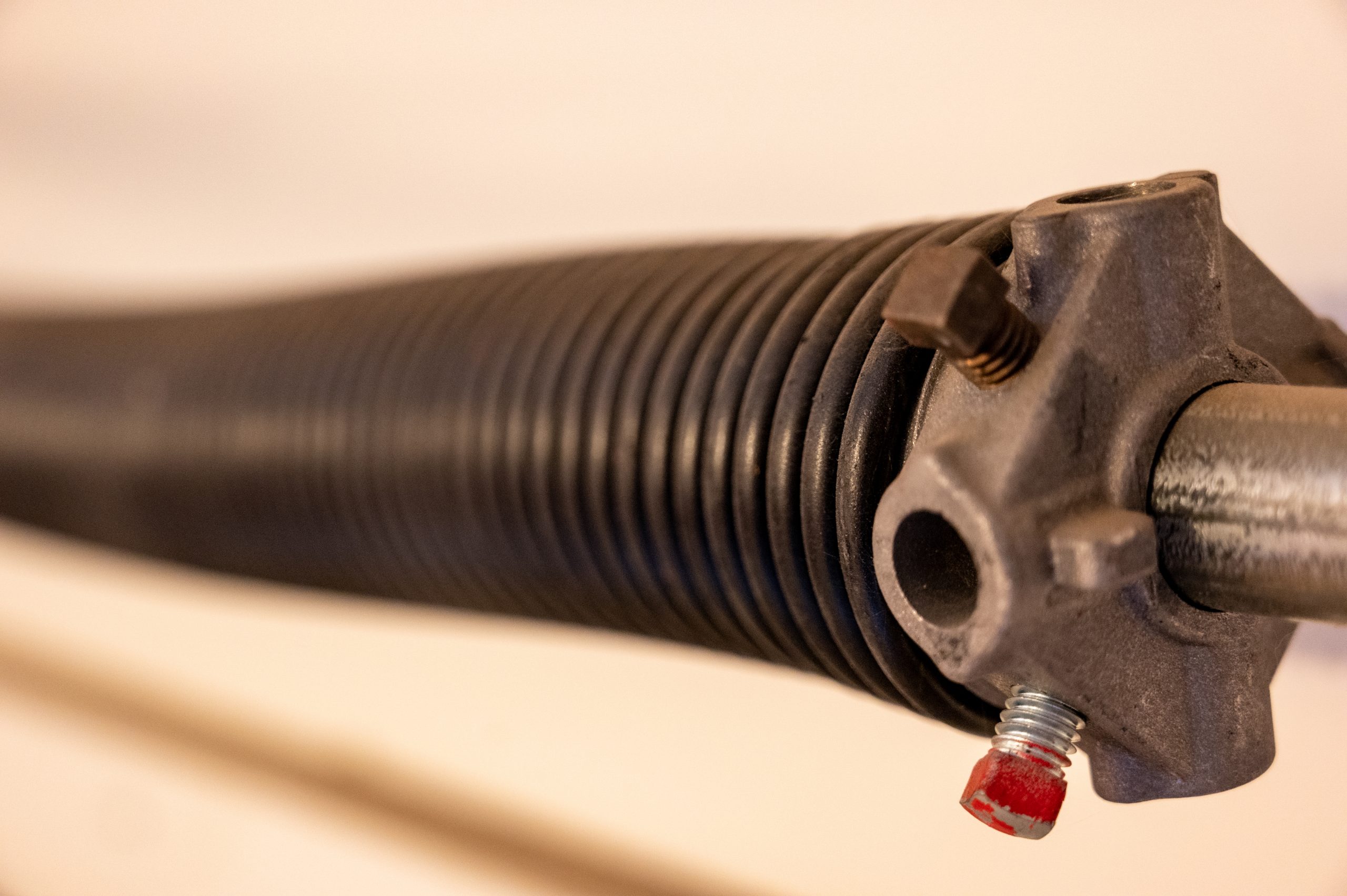Garage doors are fascinating, aren’t they? They effortlessly open and close with the touch of a button, allowing us to enter and exit our homes without a hitch. But have you ever wondered about the mechanisms behind this convenience? Well, one crucial component of a garage door is the spring. And just like any other mechanical part, garage door springs can experience wear and tear over time. So, what are the signs of a failing garage door spring? Let’s find out!
A failing garage door spring can show signs that something is not quite right. You may notice that your garage door operates slower than usual or struggles to open and close smoothly. Sometimes, you might even hear loud noises, like bangs or screeches, when the door is in motion. These signs can be indicators of a worn-out or damaged spring.
Furthermore, an unbalanced garage door could be another red flag. Take a moment to observe if your door hangs unevenly or appears lopsided when fully open or closed. If one side seems lower or higher than the other, it could be due to a failing spring. These imbalances not only affect the functionality of your garage door but can also put additional strain on the opener.
Being aware of the signs of a failing garage door spring is crucial for maintaining the security and functionality of your garage. Now that we’ve explored some common indicators, it’s essential to address these issues quickly. Regular maintenance and timely repairs can prevent further damage and ensure the longevity of your garage door system. So, join us as we delve deeper into this topic and learn more about garage door springs and how to handle potential issues.

The Signs of a Failing Garage Door Spring: A Comprehensive Guide
A garage door plays a crucial role in ensuring the security and convenience of your home. However, just like any other mechanical component, garage doors are prone to wear and tear over time. One of the most common issues that homeowners face is a failing garage door spring. Recognizing the signs of a failing spring is essential to prevent accidents, damage to your property, and costly repairs. In this comprehensive guide, we will explore the key indicators that indicate a failing garage door spring and provide insights on what steps to take to address the issue effectively.
Why Are Garage Door Springs Important?
Before delving into the signs of a failing garage door spring, it’s important to understand the crucial role that springs play in the functioning of your garage door. Garage door springs are responsible for maintaining the balance and supporting the weight of the door. Without a properly functioning spring, your garage door may become too heavy to lift or may not stay open when raised. This can not only cause inconvenience but also pose a safety risk to you and your family.
There are two types of garage door springs: torsion springs and extension springs. Torsion springs are found above the garage door opening, while extension springs are located on either side of the door. Both types of springs work by releasing stored energy to help open and close the garage door smoothly. It’s important to regularly inspect and maintain these springs to prevent any potential issues.
Common Signs of a Failing Garage Door Spring
Now that we understand the significance of garage door springs, let’s delve into the signs that indicate a failing spring. By recognizing these signs early on, you can take timely action and prevent further damage or accidents.
1. Difficulty in Opening or Closing
A primary indicator of a failing garage door spring is difficulty in opening or closing the door. If you notice that your garage door feels unusually heavy to lift or requires excessive force to open and close, it may be due to a worn-out or damaged spring. This can be especially noticeable if you have a manual garage door.
If you experience any resistance or if your garage door starts to jerk or become unbalanced during operation, it is advisable to inspect the springs for signs of wear or damage. Continuing to operate a garage door with a failing spring can lead to further damage to the door and pose a safety risk.
2. Uneven Movement
When a garage door spring is functioning properly, it ensures smooth and even movement of the door. However, a failing spring may cause the door to move unevenly or become crooked during operation. This can result in the door getting stuck or jammed at certain points, making it difficult to open or close fully.
Pay close attention to any jerky or irregular movements of your garage door, as this can be a strong indication of a failing spring. If you notice any unusual behavior, it is recommended to consult a professional garage door technician to assess and address the issue.
3. Loud Noises
If you hear loud banging or popping noises when opening or closing your garage door, it may be a sign that your springs are nearing the end of their lifespan. Over time, garage door springs can become worn out and lose their tension, which can lead to loud sounds as they struggle to support the weight of the door.
Noises like these often indicate that your springs are on the verge of failure and should be inspected and replaced by a trained professional. Ignoring these warning signs can cause the springs to snap, resulting in severe damage to the door and potential harm to anyone nearby.
4. Visible Signs of Wear or Damage
While some signs of a failing garage door spring may be more subtle, others can be obvious visual cues of wear and tear. Inspect the springs closely for signs of rust, corrosion, or fraying. If you notice any gaps or separation in the spring coils or if the spring appears stretched or elongated, it’s a clear indication that it needs to be replaced.
Additionally, keep an eye out for any broken pieces or detachment of the spring from its anchor points. These visible signs of wear and damage should not be ignored, as they can greatly impact the functionality and safety of your garage door.
5. Slow Movement
A failing garage door spring can cause the door to operate at a slower pace than usual. If you notice that your garage door is taking longer than usual to open or close, it could be a result of a compromised spring. The loss of tension and reduced power in the spring can impede the smooth and swift movement of the door.
Take note of any noticeable decrease in the speed of your garage door’s operation, as it could be an early sign of a failing spring. It’s recommended to address this issue promptly to avoid further complications and ensure the safety of your garage door.
6. Sagging or Off-Balance Door
If you notice that your garage door is sagging on one side or appears to be off-balance, it may be a clear indication of a failing spring. When a spring loses its tension or breaks, it can cause the door to become unevenly balanced, resulting in a noticeable sag or tilt.
An off-balance garage door is not only unsightly but also poses safety risks, as it can unexpectedly slam shut or become difficult to control during operation. If you observe any signs of an off-balance door, consult a professional garage door technician to inspect and rectify the issue.
7. Shorter Lifespan of the Springs
The typical lifespan of garage door springs ranges from 7 to 12 years, depending on factors such as usage, quality of the springs, and environmental conditions. If you find yourself needing to replace the springs more frequently than expected, it could be a sign of a larger underlying issue.
A shorter lifespan of the springs may indicate that they are of poor quality or that there are other factors, such as excessive usage or abnormal weather conditions, negatively affecting their longevity. In such cases, it is advisable to consult a professional to assess the situation and determine the best course of action.
Steps to Take When You Suspect a Failing Garage Door Spring
Identifying the signs of a failing garage door spring is just the first step. When you suspect that your spring may need attention, it is crucial to take the following steps to address the issue effectively:
1. Avoid Operating the Garage Door
If you suspect that your garage door spring is failing, it is best to avoid operating the door until a professional can assess and address the issue. Continued use of a garage door with a failing spring can cause further damage to the door, result in safety hazards, and increase repair costs.
Take the necessary precautions to ensure the safety of yourself and your family by refraining from using the garage door until it can be inspected and repaired by a qualified technician.
2. Contact a Professional Technician
When dealing with a failing garage door spring, it is highly recommended to seek the expertise of a professional garage door technician. Attempting to repair or replace the springs yourself can be dangerous and may lead to further damage or injury.
A qualified technician will have the necessary experience, knowledge, and tools to assess the condition of the springs, determine the appropriate course of action, and carry out the repairs safely and efficiently.
3. Regular Maintenance and Inspections
Maintaining your garage door springs in good condition is crucial for the smooth and safe operation of your garage door. Regular maintenance and inspections can help identify any issues early on and prevent major problems from arising.
Consider scheduling annual or bi-annual professional inspections to ensure that your garage door springs are in optimal condition. Additionally, perform regular visual inspections yourself, checking for signs of wear, damage, or any abnormalities in the movement of the door.
In Summary
Recognizing the signs of a failing garage door spring is essential to maintaining the functionality, safety, and security of your garage. By paying attention to indicators such as difficulty in opening and closing, uneven movement, loud noises, visible wear or damage, slow movement, sagging or off-balance doors, and shorter lifespan of the springs, you can take prompt action and prevent further complications.
If you suspect that your garage door spring is failing, it’s important to avoid operating the door and consult a professional garage door technician. They will be able to assess the issue and provide the necessary repairs or replacements to restore your garage door’s functionality. Regular maintenance and inspections are also key to preventing future problems and extending the lifespan of your garage door springs.
Key Takeaways: Signs of a Failing Garage Door Spring
- A garage door that is difficult to open or close may indicate a failing spring.
- Unusual noises, such as squeaks or grinding sounds, when operating the garage door could be a sign of a failing spring.
- If you notice a visible gap or separation in the garage door spring, it may be time for a replacement.
- An imbalanced garage door, where one side is higher than the other, could be a result of a failing spring.
- Repeated garage door failures, where the door suddenly drops or loses tension, are clear signs of a failing spring.
Frequently Asked Questions
Are you experiencing issues with your garage door? It could be a sign of a failing garage door spring. Here are some common questions and answers to help you understand the signs of a failing spring and how to address the problem.
1. Why is my garage door suddenly much heavier to lift?
If you notice that your garage door has become unusually heavy to lift, it could be a sign of a failing spring. The springs are responsible for counterbalancing the weight of the door, making it easier to open and close. Over time, garage door springs can wear out and lose their tension, causing the door to feel heavier. This issue can also be accompanied by loud creaking or grinding noises when operating the door.
It’s important to address this problem promptly, as attempting to lift a heavy garage door without a functioning spring can be dangerous. Contact a professional garage door technician to inspect and replace the failing spring to ensure safe and efficient operation of your door.
2. Why is my garage door opening or closing unevenly?
If your garage door is opening or closing in a lopsided or uneven manner, it may be due to a failing spring. Over time, the tension in the springs can become uneven, causing one side of the door to lift or lower faster than the other. This can result in an uneven appearance and potentially damage the door mechanism and tracks if left unaddressed.
A professional garage door technician can assess the situation and determine the best course of action. They may recommend replacing one or both of the springs to restore balance and even operation to your garage door.
3. Why is my garage door making loud banging or popping noises?
Unusual banging or popping noises coming from your garage door when opening or closing can be indicative of a failing spring. As the springs wear out, they may begin to make loud noises due to the tension being unevenly distributed. These sounds can be concerning and may also be accompanied by the door jerking or moving abruptly as it operates.
Contact a professional garage door technician to inspect the springs and address the issue. They can determine if the springs need to be replaced or if there are any other underlying problems contributing to the noise.
4. Can a failing garage door spring cause the door to get stuck or not close properly?
Yes, a failing garage door spring can cause the door to get stuck or not close properly. When the springs lose their tension or break, they may not provide enough force to fully close the door. This can leave a small gap, allowing drafts, pests, and even intruders to enter your garage. In some cases, the door may also get stuck in the open position, leaving your belongings exposed and compromising the security of your home.
If you’re experiencing this issue, it’s crucial to have a professional inspect and replace the failing spring to restore proper functionality and security to your garage door.
5. Are there any visual signs that indicate a failing garage door spring?
Yes, there are visual signs that can indicate a failing garage door spring. Look for gaps or separations in the spring coils, as well as stretched or elongated springs. Additionally, if you notice a noticeable imbalance in the tension between the two springs, this can suggest a problem. Rust or corrosion on the springs can also contribute to their degradation and eventual failure.
If you observe any of these visual signs, it’s advisable to contact a professional garage door technician to assess the situation and recommend the necessary repairs or replacement.

Summary
Your garage door spring is super important – it helps your door go up and down. Watch out for signs that it’s failing, like weird noises, a door that won’t stay open, or a sagging door. If you notice any of these signs, get it fixed right away to avoid accidents.
Remember, don’t try to fix the spring yourself – it’s dangerous! Call a professional to take care of it and keep your garage safe. Regular maintenance can help prevent spring problems, so make sure to take care of your garage door to keep it working smoothly.

